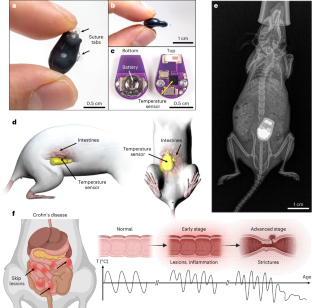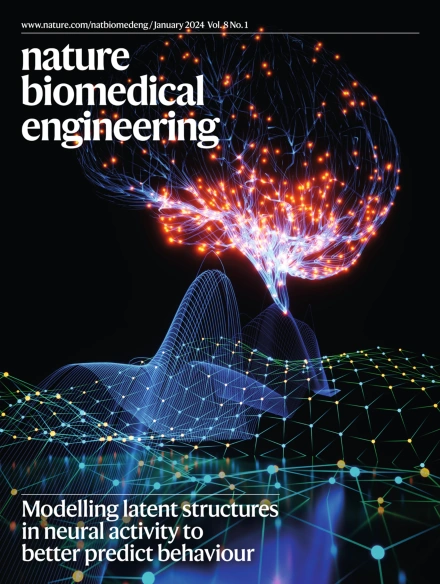用于长期监测慢性肠道炎症的微型植入式温度传感器
IF 26.8
1区 医学
Q1 ENGINEERING, BIOMEDICAL
引用次数: 0
摘要
诊断和监测克罗恩病等炎症性肠病需要使用内窥镜成像、活检和血清学检查。然而,这些并不常见的检查无法识别突然发作和严重复发的疾病,从而无法进行早期干预。因此,约 70% 的克罗恩病患者一生中都需要进行外科肠切除手术。在此,我们报告了用于实时慢性监测疾病进展的微型无线植入式温度传感器,并在克罗恩病样回肠炎小鼠模型中进行了近 4 个月的测试。腹腔内植入的传感器通过两道缝线固定在腹部肌肉组织上,对肠道温度进行局部测量,结果显示,在炎性跳动病灶出现前约 5 周,就出现了超昼夜节律。超昼夜节律与血液中应激激素和炎症细胞因子浓度的变化相关。在大约23周的时间里,平均温度不断下降,同时回肠病变中的炎症种类比例也在增加。这些微型温度传感器可在检测到炎症性肠病发作时帮助进行早期治疗。本文章由计算机程序翻译,如有差异,请以英文原文为准。


Miniaturized implantable temperature sensors for the long-term monitoring of chronic intestinal inflammation
Diagnosing and monitoring inflammatory bowel diseases, such as Crohn’s disease, involves the use of endoscopic imaging, biopsies and serology. These infrequent tests cannot, however, identify sudden onsets and severe flare-ups to facilitate early intervention. Hence, about 70% of patients with Crohn’s disease require surgical intestinal resections in their lifetime. Here we report wireless, miniaturized and implantable temperature sensors for the real-time chronic monitoring of disease progression, which we tested for nearly 4 months in a mouse model of Crohn’s-disease-like ileitis. Local measurements of intestinal temperature via intraperitoneally implanted sensors held in place against abdominal muscular tissue via two sutures showed the development of ultradian rhythms at approximately 5 weeks before the visual emergence of inflammatory skip lesions. The ultradian rhythms showed correlations with variations in the concentrations of stress hormones and inflammatory cytokines in blood. Decreasing average temperatures over the span of approximately 23 weeks were accompanied by an increasing percentage of inflammatory species in ileal lesions. These miniaturized temperature sensors may aid the early treatment of inflammatory bowel diseases upon the detection of episodic flare-ups. Wireless miniaturized implantable temperature sensors enable real-time monitoring of the progression of inflammatory bowel diseases, as shown in a mouse model of Crohn’s-disease-like ileitis.
求助全文
通过发布文献求助,成功后即可免费获取论文全文。
去求助
来源期刊

Nature Biomedical Engineering
Medicine-Medicine (miscellaneous)
CiteScore
45.30
自引率
1.10%
发文量
138
期刊介绍:
Nature Biomedical Engineering is an online-only monthly journal that was launched in January 2017. It aims to publish original research, reviews, and commentary focusing on applied biomedicine and health technology. The journal targets a diverse audience, including life scientists who are involved in developing experimental or computational systems and methods to enhance our understanding of human physiology. It also covers biomedical researchers and engineers who are engaged in designing or optimizing therapies, assays, devices, or procedures for diagnosing or treating diseases. Additionally, clinicians, who make use of research outputs to evaluate patient health or administer therapy in various clinical settings and healthcare contexts, are also part of the target audience.
 求助内容:
求助内容: 应助结果提醒方式:
应助结果提醒方式:


